System Overview
Getting Started
New to CaliberMind - Start Here!
How do I use CaliberMind's search functionality?
Company or Account Detail - Search Results
Campaign Detail - Search Results
Person Detail - Search Results
Opportunity Detail - Search Results
How Does CaliberMind Define a "Channel"?
What Is a CaliberMind Event or Event Table?
How to use Dashboards
CaliberMind Home Page - Updated
Quick Link Bookmarks
Connectors / Integrations
CaliberMind Connectors - Start Here!
Adding Your First Connector
CaliberMind Connectors
How to Connect: Act-On
How To Connect: AdRoll / RollWorks
How to Connect: G2, Bombora, or 6sense
How to Connect: Google Ads [via FiveTran]
How To Connect: Google Analytics
How to Connect: Google Sheets
How To Connect: HubSpot
How to Connect: Klaviyo [via FiveTran]
How To Connect: LinkedIn Ads
How To Connect: Marketo
How To Connect: Microsoft Dynamics
How To Connect: Outreach
How to Connect: Pardot [via FiveTran]
How to Connect: Salesforce [via FiveTran]
How to Connect: Segment [via FiveTran]
How to Connect: Twitter [via FiveTran]
How to Connect: ZoomInfo / DiscoverOrg
How To Connect: Google Campaign Manager 360
Kickfire
Setting Up the LinkedIn Push Connector
Setting Up the Salesforce Push Connector
How to Connect: Slack
Power BI/ Tableau/ Looker Connectors Article
Connecting Your Data Warehouse to CaliberMind - Start Here!
Connecting Tableau to CaliberMind
CaliberMind Data Export to Google Cloud Storage
Ingesting CaliberMind Data Into Snowflake
Pushing CaliberMind Person Engagement Data to Salesforce
Integrations Appendix by Connector
SFTP Connector - Updated 2021
Replicating CaliberMind Attribution Data to Salesforce
How to Connect Facebook Ads
How To Connect: Google Search Ads 360
KickFire De-Anonymization in CaliberMind
Field History SFDC Limits (Salesforce)
SFTP Synced Files - Making a Data Change
Connections - Email Notifications
CaliberMind Data Access FAQs
Microsoft Bing Connector [via FiveTran]
Connector Health and Web Tracker Health reports
Connectors Status Page
In-App Notifications
CaliberMind IP Addresses for Whitelisting
Developer Guide
Developer Guide - Start Here!
CaliberMind Entity Relations and System Tables
What is Google BigQuery
CaliberMind Common Data Sources
CaliberMind Identity Levels
System Configuration
Configuring Funnels
How to Set Up and Configure Funnels
Funnel Stages Configuration and Stage Definitions
Funnels FAQs Technical Documentation
Funnel Company Inclusion Configuration
Event Explore for Funnels
Funnel History Event Configuration
Funnel Static Event Configuration
Funnel Person Inclusion Configuration
Funnel Person Status Exits
Object Manager: Campaign Member
How to See Your Object Manager History and Revert Back to Previous Versions
Setting Your Saved Filters for In-App Reporting
Setting Up UTM Mapping in CaliberMind
UTM Parameters Formatting and Best Practices
Standard Channel Logic
Channel Ranking Logic
Custom SQL Data Transformations
Add BigQuery Users within CaliberMind
Remove a BigQuery User within CaliberMind
Adding Custom Columns in Salesforce
How to Email CaliberMind Reports
Setting Up Account Trend Emails
How does CaliberMind normalize the raw data for use?
List Builder
List Builder - Start Here!
What are Lists?
Creating a List Using the List Builder - Step-by-Step Instructions
Use Case Videos - Creating a List Using the List Builder
Importing a List
Downloading a List - Step-by-Step Instructions
Account List Upload - File Requirements
People List Upload - File Requirements
Campaign List Upload - File Requirements
Creating an Account List From a Campaign
Creating Company Lists in List Builder
Creating Company Lists using SQL
How to create a list of all Opportunities that have a very low Engagement
Where is my Segments Menu?
Keyboard Shortcuts using SQL
Web Tracker Installation & Settings
Web Tracker and Installation Settings - Start Here!
Installing AnalyticsJS (CaliberMind snippet)
Two ways to identify prospects that submit a form containing email address using AnalyticsJS
Install AnalyticsJS on a HubSpot website
Using AnalyticsJS Identify on embedded Hubspot forms
Using AnalyticsJS Identify on embedded Marketo forms
Types of Analytics.js Calls
Analytics.JS Overview
Using Analytics.js to Track Web and Product Events
How Cookie Settings Affect the Analytics.JS Tracking Script
Google Tag Manager (GTM) Ad Blockers
Using AnalyticsJS with Drift
Using AnalyticsJS with Qualified
How to check your AnalyticsJS implementation
Identify users using Intercom Messenger
Flows
CaliberMind's Most Popular Flows | Automations
How to use QuickFlows
Flows Status Page
Merge records in Salesforce CRM
Add a Quick-Flow to Salesforce Campaign
Using ClearBit Flows
Setting Up Workflow - Lead Deduplication
ZoomInfo - Add-to/Enrich your database
Setting Up Workflow - Website Repair
Setting Up Workflow - Account Deduplication
Creating Sales Campaigns from Salesloft and Outreach Activities
Setting Up Workflow - Contact Deduplication
Campaigns
Campaigns - Start Here!
Custom Programs for Campaigns
Campaign-Program Membership
Custom Campaigns
Program Logic for Campaigns
Setting Up Answers
Setting Up Answers - Start Here!
Using CaliberMind Answers to Understand Campaign Performance
Using CaliberMind Answers to Understand Account Engagement
Using CaliberMind Answers to Understand Funnel Performance
Using CaliberMind Answers to Understand Funnel Impact
Using CaliberMind Answers to Understand Funnel Flow
Ask Cal Custom AI Answer
Ask Cal Custom Answers: Use Cases
User Administration & SSO
Administration and SSO - Start Here!
Single Sign On (SSO) Setup
Manage Users - Viewing, Inviting, Updating Users and Roles
User Authentication and Provisioning
CaliberMind Data Warehouse Access in Google BigQuery
CaliberMind Insights Dashboards
Working in Insights
CaliberMind Insights - Browser Requirements
CaliberMind Insights - Sharing Dashboards & User Permissions
CaliberMind Insights - Navigating to Insights/Dashboard
CaliberMind Insights - Using Dashboards
CaliberMind Insights - Dashboard Refresh Schedule
CaliberMind Insights - Application Concepts and Terminology
CaliberMind Insights - Filters & Aggregation Type
Building Dashboards - Insights
Attribution Dashboards - Insights
Insights - Attribution - Start Here!
Insights - Attribution Terminology and Key Concepts
Insights - Attribution Overview Dashboard 2.0
Engagement Dashboards - Insights
Insights - Engagement - Start Here!
Insights - Engagement - Dashboard Terminology & Key Concepts
Insights - Engagement Overview
Insights - Engagement - System Account Detail
Insights - Engagement - Person Detail
Build Insights Dashboards - Start Here!
Creating a Custom Pipeline Dashboard (VIDEO)
CaliberMind Insights - Creating Custom Dashboards
Build Your Own Insights Pipeline Dashboard
Building Formulas with Functions
Insights - ROAS Dashboard Use Cases
Creating and Editing a Widget Formula
Using Conditional Statements
How is CaliberMind ROAS Reporting Different than Insights ROI?
Insights - ROI - Start Here!
How to Create a Filter Bookmark
Create Date Range Filters - Step-by-Step
Creating Formulas Based on Criteria and Conditions (Filters)
Insights Data Connector Health Dashboard
Dashboard Function Reference
Introduction to Formulas - Start Here!
Insights Web Tracker Health Dashboard
Using Quick Functions
Insights - ROAS Terminology & Key Concepts
Insights Engagement Dashboard - Aggregation Dates
Filters
Object Mapping for Filters - Start Here!
Custom Configuration for Object Mapping
Object Mapping Filters
How to Map Your Salesforce Opportunity Revenue Field
Object Mapping: Create a Filter
Object Mapping: Create a Mapping
Object Mapping: Create a Replacement
Object Mapping: Create a Campaign Substitution
Filters Update for Creating Filter Sets
Filter Drawer Definitions
CaliberMind Sandbox
GDPR Compliance with CaliberMind
Data Dictionary
Attribution
Analytics
Attribution
Attribution Overview: Summary Tab
Attribution Overview: Comparisons Tab
Attribution Overview: Explore Tab
Attribution Overview: Opps Tab
Attribution Overview: People Tab
Attribution Overview: Events Tab
Campaign Types: Best Practices for Easy-to-Read Attribution
Virtual Campaigns in CaliberMind
Attribution - CaliberMind versus Embedded Attribution in Salesforce?
Removal effect with a Markov chain model
Attribution Reports Summary
Demand Generation
Data Integrity
Customer Success
Understanding Reports
CaliberMind Analytics Concepts
Overview of Analytics and Attribution
Filters and Hyperlinks
Using the Engagement Trending Report
Analytics Reporting: Salesforce Custom Column Filter Support
Using Tags to Organize Your Lists
Attribution Overview - Campaign Performance Table
Using Campaign Lists in Dashboards
Using Company Lists in Dashboards
CaliberMind Metrics Definition
Product Attribution Dashboard
Self-Hosting CaliberMind AnalyticsJS
ROI
Revolutionizing Marketing ROI: CaliberMind's Innovative New Approach
Return On Ad Spend Dashboards
Revenue Contribution Reports Summary
Channel ROI Overview
Creating and maintaining a custom advertising budget for ROAS
Best Practices for Tracking Return-on-Ad-Spend (ROAS)
Why Is CaliberMind ROAS or ROI Different Than My Ad Platform?
Campaign ROI Overview
Budget for ROI Channel Reporting
Attribution Models
Choosing the Right Attribution Model
Attribution Models: First-Touch
Attribution Models: W-Shaped
Attribution Models: Middle
Chain-Based Attribution Model
The A-Shaped Model
Configurable Widgets
Ad Performance Report - Summary Tab
Ad Performance Report - Attribution Tab
Funnels
Funnels 101
Funnels - Start Here!
Marketing & Sales Funnel Foundations
What is a Marketing Funnel?
Sales Funnel Journey: Questions and Answers
Common Funnel Issues
Sales Funnel Glossary
Funnel Stage Definitions
Funnel Terms and Concepts
Sales Funnel Metrics
What is the difference between an Active Journey and a Journey?
In-App Funnels
Funnel Overview: Summary Tab
Funnel Overview: Progression Tab
Funnel Overview: Cohort Tab
Funnel Overview: Stage Analyzer Tab
Funnel Overview: Comparison Tab
Funnel Overview: Journeys Tab
Insights Funnels
Funnels Use Cases
What channels move journeys through a given stage?
How can I see the number of journeys in or passing through a funnel stage during a period of time?
What touches are influencing each step in the funnel?
How do I see the first event (or "tipping point") in each stage of my funnel?
Where are my customers stuck in journeys?
How do I know the last event that happened before a journey stage change?
How do I identify stage conversion rates?
Funnel Configuration - Insights
Funnel Trigger Events Dashboard
Insights Funnels Reports Explained
Funnel Trend Dashboard
What is a Starter Funnel?
Funnel Cohort Analysis Dashboard
Funnel Cohort Analysis Use Cases
Funnel Data Explore Dashboard
Introducing CaliberMind's Funnels
Funnels - Lead, Contact, Account, Opportunity Statuses and Stages
Pressure Event Dashboard 101
Demand Generation Funnel Dashboard
Engagement and ABM
Engagement Scoring
Model Configuration
Customize Engagement Scoring Models - Start Here!
Engagement Scoring Models Overview
How to Change Event Touch Scores
How to Add or Change Engagement Score Multipliers
Add or Change Engagement Score Filters
Create Multiple Engagement Score Models
Which touches and events are we scoring?
Sales Opportunity Data Model
Engagement Scoring Time Decay - How It Works & How to Change It
Custom Attribution Configuration - Custom Weighting
Using Engagement Score to Trigger an Update in Salesforce
Default ABM Scoring Logic
Recommended Weights for Engagement Scores
Engagement Reporting
Engagement: Summary Tab
Engagement Overview: Companies Tab
Engagement Overview: People Tab
Engagement Overview: Campaigns Tab
Engagement Overview: Explore Tab
Company Engagement AI Summary
Account-Based Marketing Reports
Linking to CaliberMind Reports in Salesforce
ABM Best Practices
Account-to-Lead (A2L) Matching
Lead-to-Account Matching (L2A)
Pushing CaliberMind ABM Scoring Fields to Salesforce.com
Slack AI Company Engagement Summary
3rd Party Intent Signals with Bombora
Tutorials and Use Cases
Digital Marketing Terminology
Customizing Report Visibility (Show/Hide)
How to Manage Your Offsite Events Using CaliberMind
How can I manage my BDR/SDR team activities with CaliberMind?
Combining Engagement Score with Attribution
Enabling the Sales Teams to see the Entire Buyers Journey
How Can I Identify High Risk Opportunities?
How does Sales leverage CaliberMind? Some key use cases.
Running a Sales/Pipeline Review with CaliberMind
How Is CaliberMind Different From My CRM Attribution?
CRM Campaign Member Status and Campaign Response Best Practices
How Do I Optimize Advertising Spend?
Campaign Best Practices Across Systems
How do I use CaliberMind to shorten our sales cycle?
Answering Business Questions Using CaliberMind Reports
Which of my leads are the most engaged?
How Do I Know If a Campaign Is Good or Bad?
How to Flatten Your Campaign Structure in Salesforce
Table of Contents
- All Categories
- Tutorials and Use Cases
- How Do I Know If a Campaign Is Good or Bad?
How Do I Know If a Campaign Is Good or Bad?
What Makes a Campaign “Good” or “Bad”?
Campaigns do a broad array of things, so we’ll look at multiple metrics and CaliberMind products to determine whether a campaign is good or bad. In the past, I’ve used a multi-metric approach to great success for tradeshows and other costly in-person events. I now use this method to defend community partnerships and other co-branded plays that have a decent investment attached to them.
The spreadsheet contained the campaign name in column A, and then we populated the following:
- Date of Campaign
- Campaign Cost
- Number of qualified leads
- “Sourced" opportunities
- Multi-Touch Pipeline
- Multi-Touch Bookings
- ROI (MTA Bookings)
- Qualitative Feedback from Sales
Field marketers pointed out that some events looked terrible when it came to lead generation, but the salespeople raved about them. The spreadsheet helped us separate the events that felt good (suitable venue, fun conversations) but didn’t perform well. That enabled us to repeat and focus on the most beneficial campaigns and brainstorm new events to replace the bad.
An example would look something like this:

I still use the above method for more expensive tactics. For digital advertising, I use a multi-touch attribution model to determine return on ad spend (more on that here) and then use funnel pressure and trigger reports to determine if the campaigns had an early funnel impact that isn’t translating into pipeline yet. This also helps me see whether I’m attracting the right audience and will ever see ROI.
For early awareness plays, the impact is more intangible. For example, we can watch early indicators like engagement for increased website traffic volume and other content consumption when branding changes or PR occurs.
While we’ve given you a comprehensive outline of where to look for different kinds of campaigns, you can judge them by as many or as few factors as you’d like–just remember that awareness plays and sales engagement plays are likely to be hard to defend if you’re only looking at lead volume and sourcing (last touch) data.
Using Attribution to Understand Campaign Impact
Different models answer different questions (which we go into more detail here).
Campaign Influence / Pipeline & Bookings
We suggest using a single multi-touch model that looks at both pre- and post-opportunity data (either even-weighted or chain-based) to estimate total influenced (both pre-opportunity and post-opportunity) dollars. Using these models, we can separate which campaigns are good at getting people to engage with sales (pre-opportunity) from those that are good at getting people to re-engage or stay engaged with sales (post-opportunity).
Our webinars are a tool for sales to keep in-flight opportunities engaged. Some topics are appealing enough to lure people in. We’d likely repeat ROC (RevOps Co-Op) related events and certification courses. We’d also repeat the back-to-basics boot camp format.
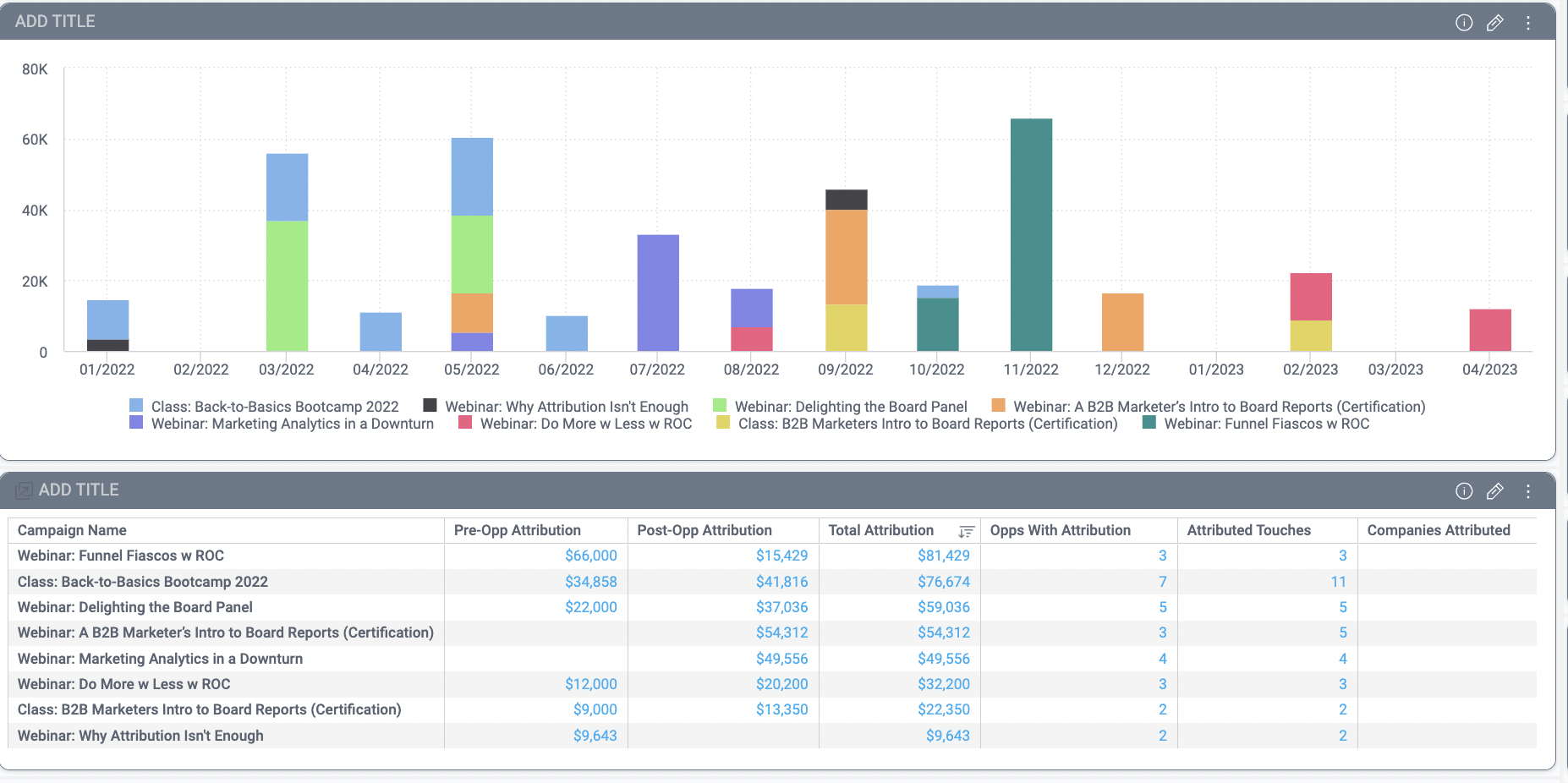
ROI Estimates
Our ROI reports in Insights look at the campaign spend data you have entered in your CRM or are listed against each campaign in your advertising platform. Then, we calculate how much bookings the associated touch is responsible for using whichever model you select. We recommend a model that views pre- and post-opportunity touches to demonstrate the full impact of events that tend to keep deals propelling forward (like webinars and in-person events).
Check out this article for more on what a good or bad ROI result looks like.
Demand Generation Statistics
Instead of assigning dollars to evaluate opportunities sourced and accounts sourced, we suggest starting single-touch models and representing the campaign’s impact. In this case, we recommend a middle touch model or the last thing that happened before opportunity creation (as CaliberMind defines it).
Lead Generation Statistics
Instead of assigning dollars to evaluate opportunities sourced and accounts sourced, we suggest starting single-touch models and representing the campaign’s impact. For example, a First-Touch model can be impactful if you want to understand which campaigns are the best at building awareness.
Using Funnels to Understand Campaign Impact
While attribution, by definition, is the value of the opportunity split across critical touchpoints, funnels divide touchpoints by which stage of the funnel the account is in, allowing for more granular impact analysis. In addition, because opportunities don’t need to be associated with a journey to track the earliest stages, it’s also a great way to see early indicators that a campaign is developing traction with your ideal customer profile.
Trigger Events
Trigger events show which events or campaigns were THE THING to tip someone over in the stage you’re analyzing. These are a great way to think of “sourcing” by stage.
In the example below, I will analyze the Marketing Qualified Account stage to see which campaigns are the most successful at getting prospects to engage with our brand.
- Go to Insights and click on the Funnels Trigger Events dashboard:
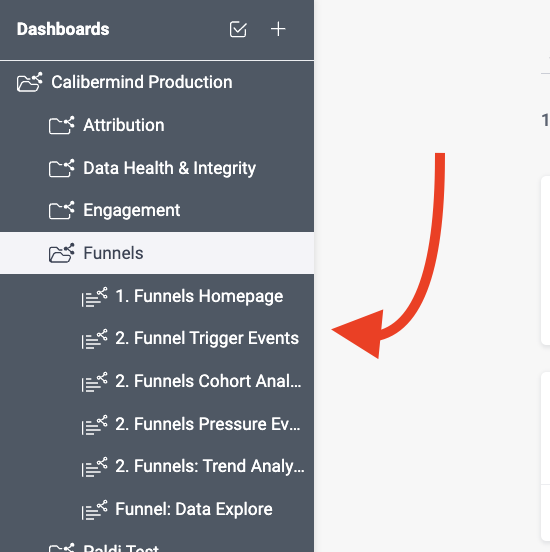
- Set the time period you want to analyze (1), select the stage you want to analyze (2), and modify the time increment (months, quarters, weeks) granularity for the chart (3):

- Next, click on the Campaign Tab:
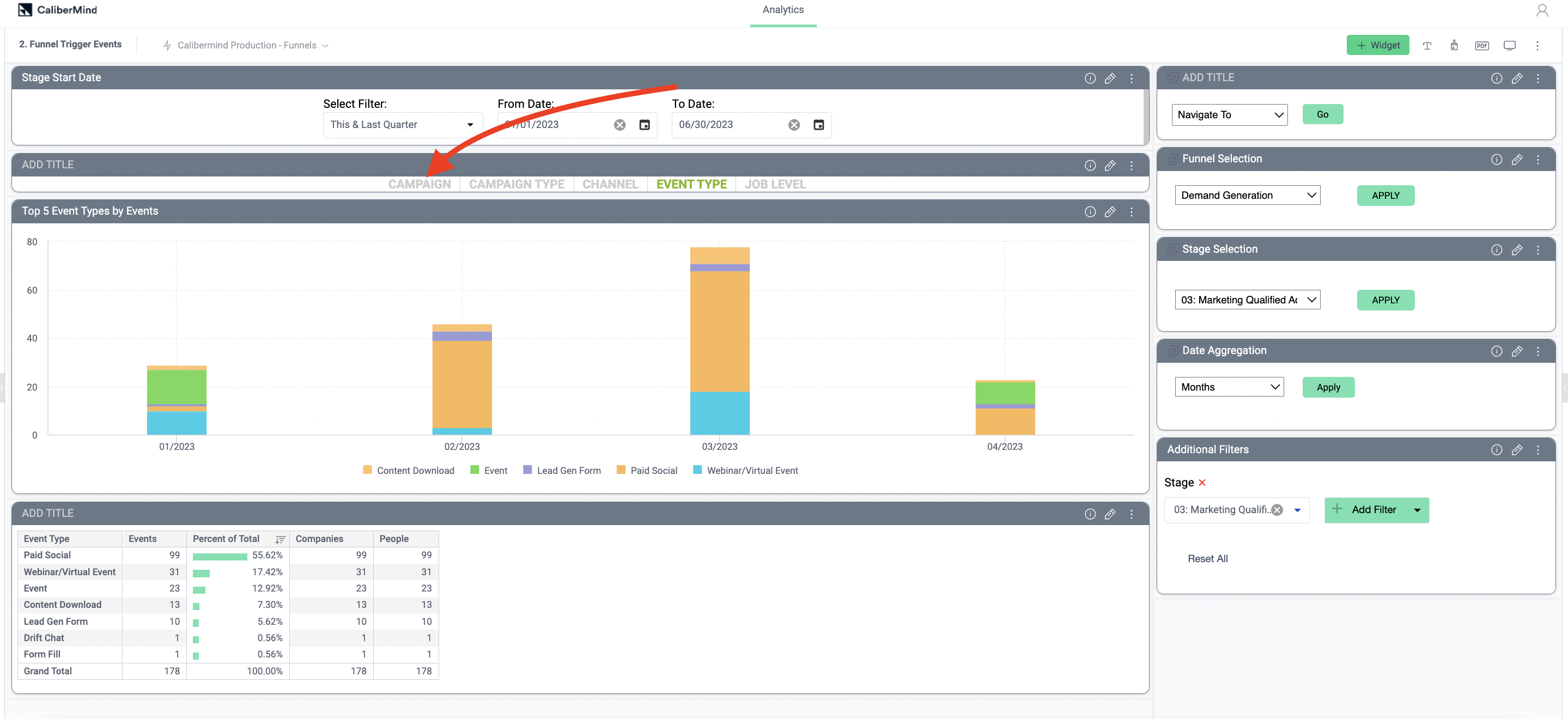
- The campaigns will be sorted by the frequency or number of accounts that hit the stage by performing the action.
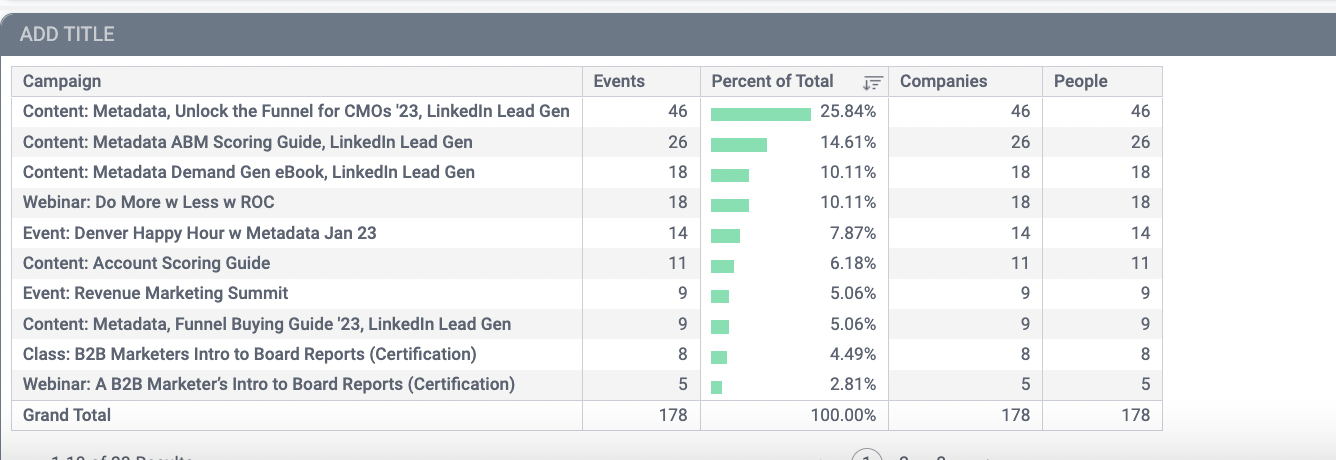
Let’s look at our Inbound stage to see how different campaigns impact different stages of the funnel.
- On the Trigger Events dashboard, select your first stage of the funnel:
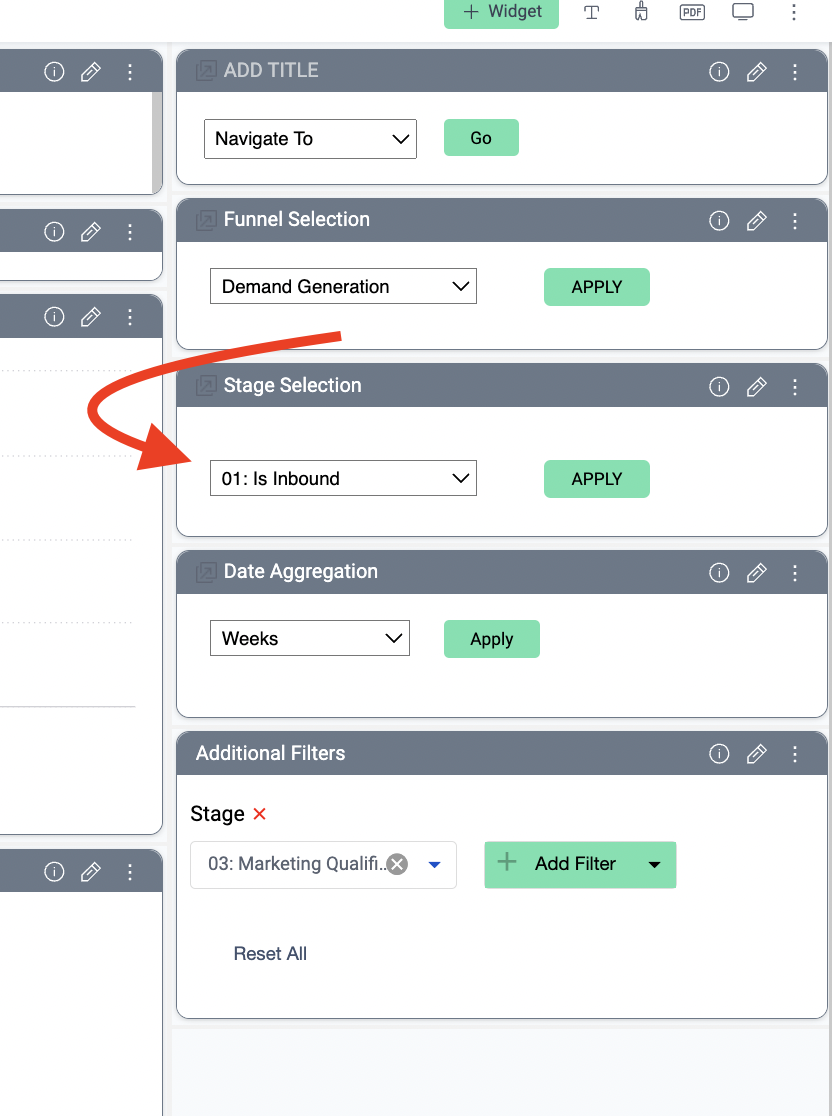
- See how the campaigns differ from our previous list:
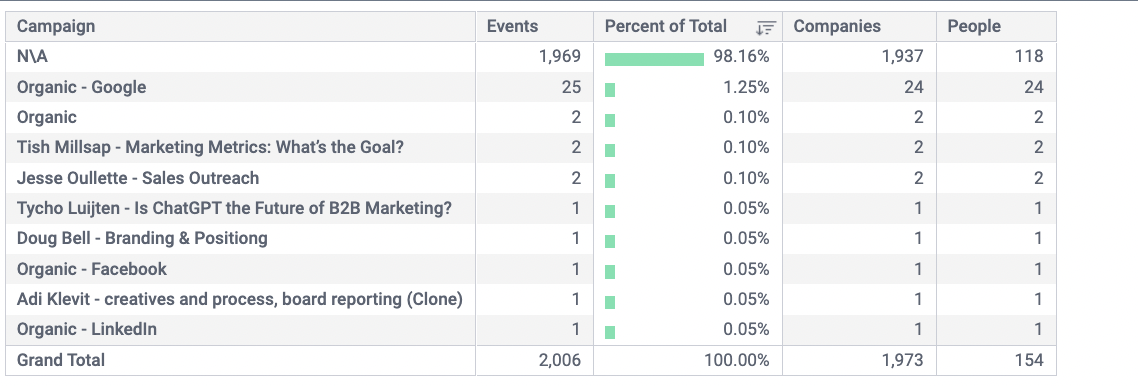
For more on Trigger Events and how to use them, click here.
Pressure Events
Pressure events help us see which activities are influential between stages. For example, this allows us to see content consumption or SDR email campaigns that help keep someone engaged even though they may not meet the threshold for tipping the person or account into the next stage.
This report is helpful for understanding which events help keep buyers engaged once an opportunity is created.
- Go to the Pressure Events dashboard.
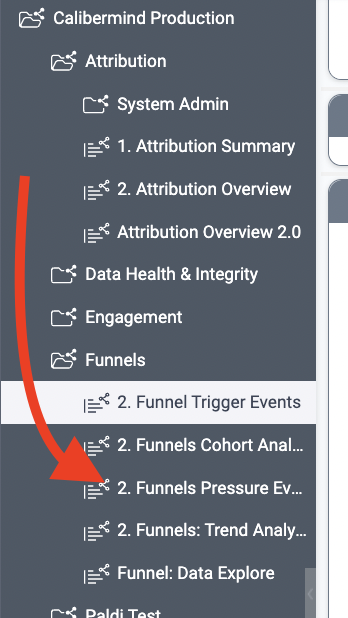
- Set the period you want to analyze (1), select the stage you want to analyze (2), and the end stage or “success criteria” (3). The end stage applies a quality gauge for accounts and emphasizes the successful journeys versus those that ended early.
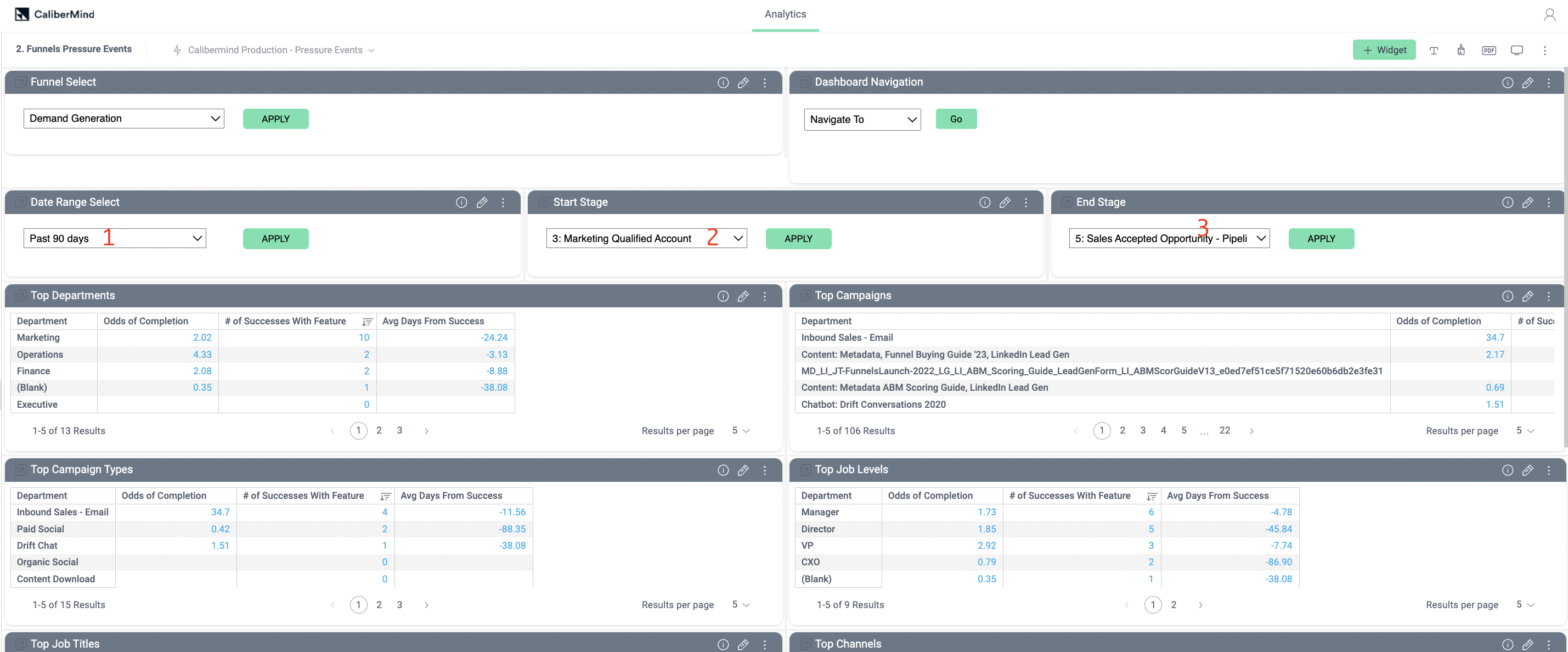
- Review which campaign types and campaigns are the most influential for that stage for accounts that progressed to the end stage.

For more on Pressure dashboards, click here.
Using Surge Scoring (Engagement) Data to See Early Impact
It’s never a good idea to wait for a deal to be booked before judging whether a campaign is doing well (or not). It takes too long! The earliest indicators we offer live in the funnel (early stages) and in surge scoring.
- To evaluate a campaign, go to the Engagement Overview in Insights:
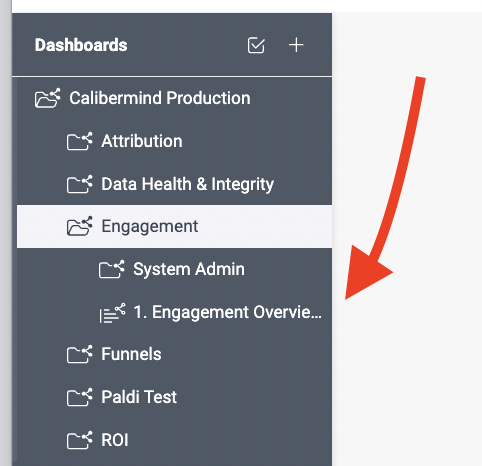
- Add a filter for Campaign Source to narrow your list down to the system you’re interested in. In this case, we’ll select LinkedIn:
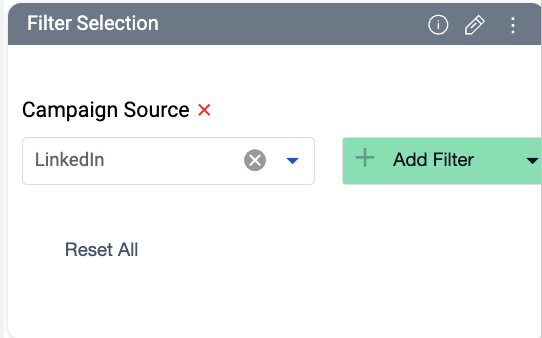
- In this example, you can see we had a serious increase in budget dedicated to LinkedIn to run some tests:

- We’ll look at job level, department, and industry to see whether we targeted the right audience. Let’s start with job level:

Many of our ads targeted senior executives in the marketing department. Do you think our targeting worked?
When using our earliest indicators, we suggest using engagement or surge scoring data to understand whether your target audience matches your expectations and whether the increase in additional spend is proportionate to the rise in engaged accounts.
